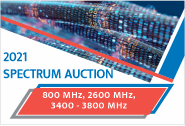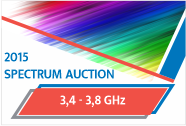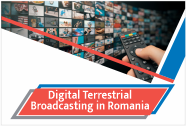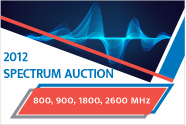Radio Spectrum
Background
Â
According to the national legislation in force, the radio frequency spectrum (radio spectrum) is that portion of the electromagnetic spectrum which comprises radio waves with frequencies ranging between 9 kHz and 3000 GHz.
The radio spectrum is a limited natural resource and, therefore, it must be managed efficiently and rationally, bearing in mind the public, the social and the national defence interests, while maximising the benefits for the spectrum users (providers of electronic communications networks and/or services, private operators or end-users).
Â
According to the ITU Radio Regulations, the radio frequency spectrum is divided into nine frequency ranges:
- VLF - from 3 kHz to 30 kHz (very low frequencies),
- LF - from 30 kHz to 300 kHz (low frequencies),
- MF - from 300 kHz to 3000 kHz (3 MHz) (medium frequencies),
- HF - from 3 MHz to 30 MHz (high frequencies),
- VHF - from 30 MHz to 300 MHz (very high frequencies),
- UHF - from 300 MHz to 3000 MHz (3 GHz), (ultra high frequencies),
- SHF - from 3 GHz to 30 GHz (super high frequencies),
- EHF – from 30 GHz to 300 GHz (extra high frequencies),
- from 300 GHz to 3000 GHz.
Â
The uses of the radio spectrum are classified into radiocommunication services, taking into account the technical and operational characteristics of its use. Radiocommunication services are an exclusively technical concept, which is different from electronic communications services, the provision of which is made in conformity with regulations adopted at European Union level and implemented in the national legislation. The definitions of the radiocommunication services were elaborated and are updated by the International Telecommunications Union (ITU), taking into account the technological innovation and progress at global level.
Â
In Romania, the most important and the most widely used radiocommunication services are: land mobile service, sound broadcasting and television service, fixed service, maritime mobile service and maritime mobile-satellite service, aeronautical mobile service and aeronautical mobile-satellite service, fixed-satellite service, land mobile-satellite service, radiolocation service, maritime and aeronautical radionavigation service, meteorological aids service.
Â
The radio spectrum is actually used by means of radiocommunications stations and terminals. These may operate individually or may be part of radiocommunication networks. The operators observing the general authorisation regime use the spectrum to provide public electronic communications networks and/or services, whereas other operators or holders of such radiocommunication stations use the spectrum for their own needs.
Â
 Â

Spectrum management
Â
One of the major objectives of ANCOM is to manage the whole radio spectrum throughout the Romanian territory, the Romanian airspace,as well as in the inland waterways and maritime area under its jurisdiction. In order to achieve this objective, ANC applies the long-term policy and strategies for spectrum management developed by the Ministry of Communications and Information Technology (MCTI).
Â
In Romania, spectrum management complies with the principles of objectivity, proportionality, transparency, impartiality and, where possible, of technological neutrality.
Â
The main spectrum management activities performed by ANCOM, directly or in collaboration with other institutions are the following:
Â
1) elaboration and adoption of specific legislation in the field of electronic communications using the radio spectrum (rules, specifications, standards and other technical and administrative regulations in the field of radio spectrum); also, ANC is directly involved in the elaboration of the main corpus of legislation in the electronic communications sector (general regulatory framework for electronic communications, Universal Service etc);
Â
2) planning of the whole radio spectrum, by:
a) allocation of frequency bands; for this purpose, ANCOM takes part in the development of the National Table of Frequency Bands Allocations (NTFA), which is adopted by the Ministry of Communications and Information Technology(MCTI);
b) designation of frequency bands for various applications and radiocommunication systems, allotment of frequencies or frequency bands to categories of users;
c) elaboration of strategies for spectrum planning and use; ANCOM is directly involved in the elaboration of these strategy documents, which are subsequently adopted by MCTI;
Â
3) detailed management of the radio spectrum, having an exclusive or shared non-governmental status of use according to the NTFA, in view of its rational and efficient use, by:
a) spectrum engineering, which means conducting technical checkups aimed at an efficient and rational use of the radio spectrum, as well as at elaborating strategies and plans for the use of the radio frequencies; it also comprises technical analysis and checkups of the frequency usages in view of preventing harmful interferences and of ensuring radioelectric compatibility between the authorised radiocommunication stations and networks and newly requested radiocommunication stations and networks, in order to assess the possibility of identifying new frequency assignments/allotments for the latter;
b) assignment and allotment of radio frequencies/frequency bands, while observing the national and international technical and administrative regulations, the internal agreements and protocols and the international treaties and agreements to which Romania is party, regarding the use of the radio spectrum;
c) issuing the licences for the use of radio frequencies and the broadcasting licences, by which rights to use the radio spectrum are granted;
d) keeping account of the radio spectrum usages, by means of specialised databases which are constantly updated: National Plan of Frequency Allotments (NPFA) and the National Register of Frequency Assignments (NRFA);
e) coordination of the use of frequencies at a national level, with the governmental institutions in charge of managing certain portions of the radio spectrum according to the legal provisions in force, as well as at an international level, with the Communications Administrations of other countries, by applying the technical and administrative procedures provided in the international agreements to which Romania is party.
Â
ANCOM ensures the detailed management of the “civil bands” (with non-governmental status of use according to the NTFA), while the governmental institutions in the National Defence System ensure the detailed management of the “governmental bands” (with governmental status of use according to the NTFA). ANCOM manages the frequency bands with shared governmental/non-governmental status of use, being assisted in this respect by the Interdepartmental Radiocommunication Commission, a consultative body chaired by MCTI.
Â
4) monitoring the use of the radio spectrum with non-governmental status of use by:
a) a priori monitoring, which assists the activity of radio spectrum detailed management, by identifying unoccupied and interference-free radio frequencies in a given geographical area,
b) a posteriori monitoring, which assists the activity of checking the licence holders’ compliance with the obligations provided in the licences for the use of radio frequencies or in the broadcasting licences (and in the authorisations attached to the licences).
Â
5) control the use of the radio spectrum with non-governmental status of use by:
a) surveillance and control of the licence holders’ compliance with the obligations provided in the licences for the use of frequencies or in the broadcasting licences (and in the authorisations attached to the licences),
b) surveillance and control of the licence holders’ compliance with the provisions of technical and administrative regulations in force in the radio spectrum (radiocommunication) field,
c)surveillance and control of compliance with the provisions of the regulations in force and of the international treaties and agreements on the use of the radio spectrum, to which Romania is party.
Â
ANCOM also conducts activities that are ancillary to radio spectrum management, such as:
Â
1) management of other limited resources, ancillary to radio spectrum management activities, by:
a) assigning callsigns allotted to Romania by the ITU, for the following radiocommunication services: maritime mobile service and maritime mobile-satellite service, aeronautical mobile service and aeronautical mobile-satellite service, on the inland waterways, as well as the amateur service,
b) assigning identification codes (alphanumerical identities) for certain types of radiocommunication stations operating in the following services: maritime mobile service and maritime mobile-satellite service, on the inland waterways (e.g.: MMSI, ATIS, etc),
Â
2) testing and certification of the personnel operating radiocommunication stations in the following services: maritime mobile service and maritime mobile-satellite service, aeronautical mobile service and aeronautical mobile-satellite service, radiotelephone service on the inland waterways, land mobile service (only certain types of radiocommunication networks for this service).
Â
3) testing and certification of the radioamateurs, as well as authorising the radiocommunication stations that they hold and/or use in the amateur service,
Â
4) keeping account of the operations for the activities mentioned under the three items above.
Â
5) publishing the register of the personnel operating radiocommunication stations and holding certificates issued by ANCOM and publishing the register of the authorised Romanian radioamateurs (callbook).

Radio spectrum use
Â
The fundamental document for the radio spectrum management in Romania is the National Table of Frequency Bands Allocations (NTFA), which encompasses information regarding:
- allocations of frequency bands to radiocommunication services in Romania, comparing them with regional and European allocations;
- designations of radio frequency bands in Romania for the pan-European radiocommunication systems and for various systems or applications, the use of which is harmonised at European level, comparing them with European designations;
- other possible applications in various radio frequency bands;
- technical regulations and rules applicable in Romania for various radio frequency bands;
- status of use (exclusive or shared, governmental/non-governmental) for each radio frequency band.
Â
The radio spectrum may be used by transmission or by reception.
Transmission in the radio spectrum is possible only upon obtaining a licence for the use of radio frequencies or a broadcasting licence, as the case may be, issued by ANCOM, excepting certain categories of frequencies which can be used freely, on a licence-exempt basis, for certain types of applications and under the strict observance of certain technical and operational parameters (further details are available in the”Equipment” section).
Reception in the radio spectrum is free, excepting specific situations provided in the procedure for licensing the rights to use the radio spectrum, cases in which a licence for the use of radio frequencies issued by ANCOM is required (in view of ensuring the radioelectric protection for the respective receptions).
Â
In Romania, a licence for the use of radio frequencies may be obtained either upon direct granting procedure or by a comparative or competitive selection procedure.
ANCOMÂ issues broadcasting licences by direct granting procedure , to the holders of audio-visual licences issued by the National Audiovisual Council (CNA), which grants such licences by a competitive procedure.
The direct granting procedure for issuing licences for the use of radio frequencies and frequency assignments authorisations enclosed thereto, as well as the situations or cases where the selection procedure is enforced instead, are available for consultation in Decision no.658/2005.
The procedure for issuing the broadcasting licences and the technical authorisations attached thereto is available for consultation in Decision no.629/2010.
Â
The radiocommunication operators must use the radio spectrum efficiently and rationally, without producing harmful interferences to other legitimate users of the radio spectrum.
ANCOMÂ guards these principles by imposing technical and operational terms in the licences, as well as technical and operational parameters in the authorisations attached to the licences.
Â
The holders of licences for the use of radio frequencies and the holders of broadcasting licences owe ANCOM the annual tariff for the use of the radio spectrum. The reception of radio waves is not chargeable.
Further details on the procedure and the list of tariffs for the use of the radio spectrum currently in force are available for consultation in Decision 551/2012.
Â
The requesters of licences for the use of radio frequencies may find themselves in one of the following situations:
- they are providers of electronic communications public networks and/or services (as the case may be for: sound broadcasting and television service, certain types of networks in the following services: land mobile (e.g. cellular mobile telephony networks), fixed service (e.g. point-multipoint networks for data transmissions), fixed-satellite service, mobile-satellite service),
- they intend to use the radio spectrum for their own needs (this is applicable to all the radiocommunication services in the ITU list), and offer a pertinent reason therefore, explaining the impossibility of fulfilling their communication needs by other means/technologies that do not use the radio spectrum,
- they are compelled to use the radio spectrum in order to conduct specific activities or accomplish specific tasks within other sectors than electronic communications, which – by their nature – may not be conducted/accomplished unless the radio spectrum is used (e.g.: radiocommunications for the maritime mobile service and the aeronautical mobile service, the radiolocation service and the maritime and aeronautical radionavigation services).
The requesters of broadcasting licences may only be the holders of audiovisual licences issued by CNA.
Â
The personnel operating radiocommunication stations shall be certified only if these stations are operating in the following radiocommunication services: maritime mobile service and maritime mobile-satellite service, on the inland waterways, aeronautical mobile service and aeronautical mobile-satellite service, as well as in certain situations in case of the land mobile service.
Details on the procedure of certifying the operating personnel and the applicable examination syllabus, as well as on the operator’s certificate holders’ competences and obligations are available in Radio operators” section.
Â
Generally, the radioamateurs are a special category of users of the radio spectrum. This category is granted special attention in Romania, too. The technical rules and terms on the use of the radio spectrum by the radioamateurs, the procedure of certifying the radioamateurs and the applicable examination syllabus, the procedure of authorising radiocommunication stations in the amateur service, as well as the rules of the radioamateur activity are available for consultation in Radioamateurs” section.
Â
Â
International activities of ANCOM in the field of the radio spectrum
Â
In view of the efficient achievement of the radio spectrum management objective in Romania, ANCOM keeps up-to-date with the global developments in this field, with the evolution of radiocommunication technologies and takes an active part in the currently ardent debates, on topics such as: the convergence of the electronic communications networks and services, the efficient use of the radio spectrum, the technological convergence in the radiocommunication field, where new trends and speciality concepts are engendered, which are relevant for the field of radio spectrum, in general, therefore affecting also radio spectrum management activities.
In this respect, ANCOM prepares national position papers and takes part in international radio spectrum management activities, collaborating with international bodies and institutions which are active in the radiocommunication field.
Â
Thus, ANCOM takes part in the meetings of the international bodies and organisations having tasks and activities that relate exclusively to the field of electronic communications (European Conference of the Post and Telecommunications Administrations – CEPT, International Telecommunication Union – ITU) or that include the field of electronic communications (European Union – EU, International Maritime Organisation – IMO, International Civil Aviation Organisation – ICAO, North-Atlantic Treaty Organisation – NATO).
This activity involves:
- preparation of the national position on the issues discussed in the plenary sessions, as well as in the meetings of the committees, working groups and sub-groups of the above-mentioned international bodies and organisations, in agreement with MCSI,
- direct participation in the plenary sessions, as well as in the meetings of the committees, working groups and sub-groups of the above-mentioned international bodies and organisations, where ANCOM presents and sustains the national position and offers professional technical support to MCSI, which represents Romania in the international bodies and organisations in which our country is a member.
Among the concrete results of this activity, we mention:
1) at the ITU level, the signing of various international agreements to which Romania is party:
- Final Acts of the World Radiocommunication Conferences (that permanently update the ITU Radio Regulations),
- Final Acts of the Plenipotentiary Conferences (that permanently update the ITU Constitution and Convention),
- regional radiocommunication agreements and associated plans of frequency channels allotments, especially for the following services: sound broadcasting and television (Stockholm 1961 – ST61, Geneva 1975 – GE75, Geneva 1984 – GE84, Geneva 2006 – GE06), broadcasting-satellite service (appendix 30 of the ITU Radio Regulations), fixed-satellite service (appendices 30A and 30B of the ITU Radio Regulations),
as well as resolutions, recommendations and reports applicable at an international level.
2) at the CEPT level, the signing of various regional agreements to which Romania is party:
- Wiesbaden 1995 regional arrangement, revised at Constanta in 2007 – Wi95revCO07,
- Maastricht 2002 regional arrangement, revised at Constanta in 2007 – Ma02revCO07, as well as decisions, recommendations and reports applicable at the CEPT level.
Â
ANCOM closely cooperates with foreign regulatory authorities in the field of radiocommunications. In this concern, ANCOM takes part in bilateral and multilateral meetings for the coordination of the use of radio frequencies, especially in, but not limited to, the border areas, for various radiocommunication services: land mobile service, sound broadcasting and television service, fixed service, on the inland waterways.
Among the concrete results of this activity, we mention the signing of some regional agreements to which Romania is party:
- HCM Agreement (2008) for the land mobile and the fixed services,
- RAINWAT Regional Arrangement (Basel, 2000), for the radiotelephone service on the inland waterways,
- multilateral and bilateral agreements with the neighbouring countries, for the following radiocommunication services: land mobile service, fixed service, sound broadcasting and television service.








 top
top
